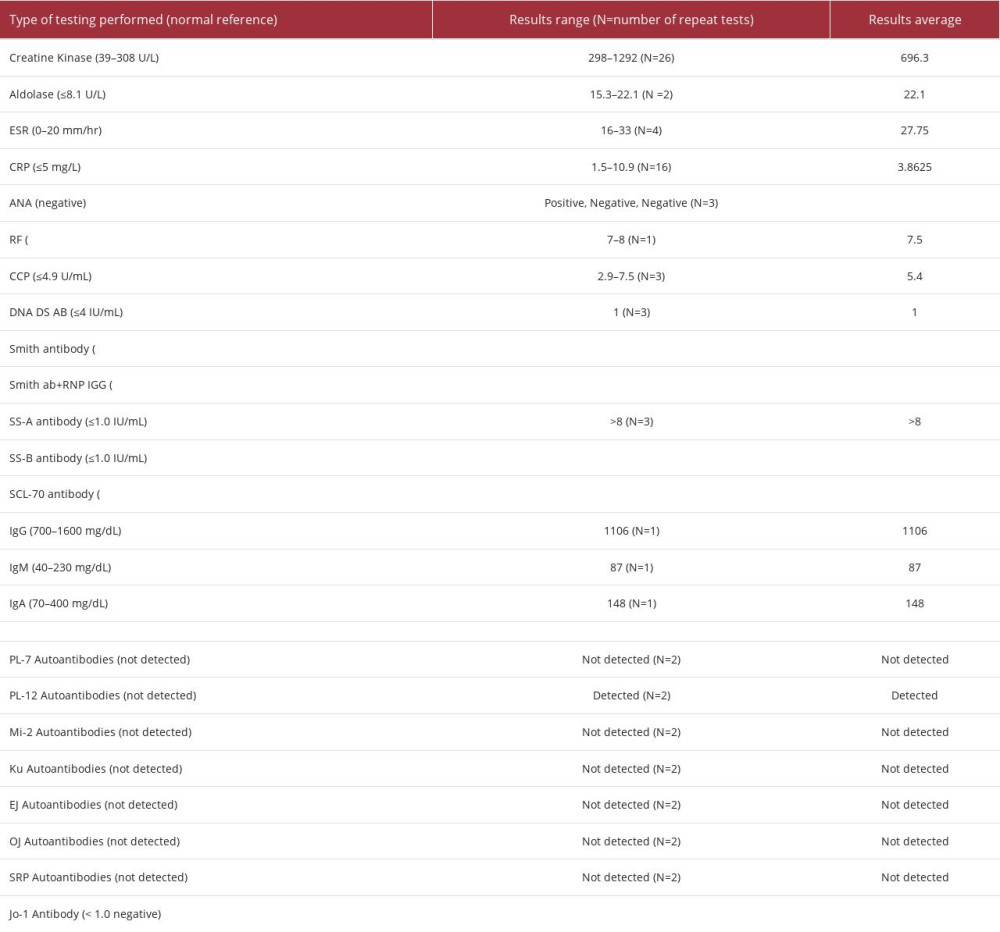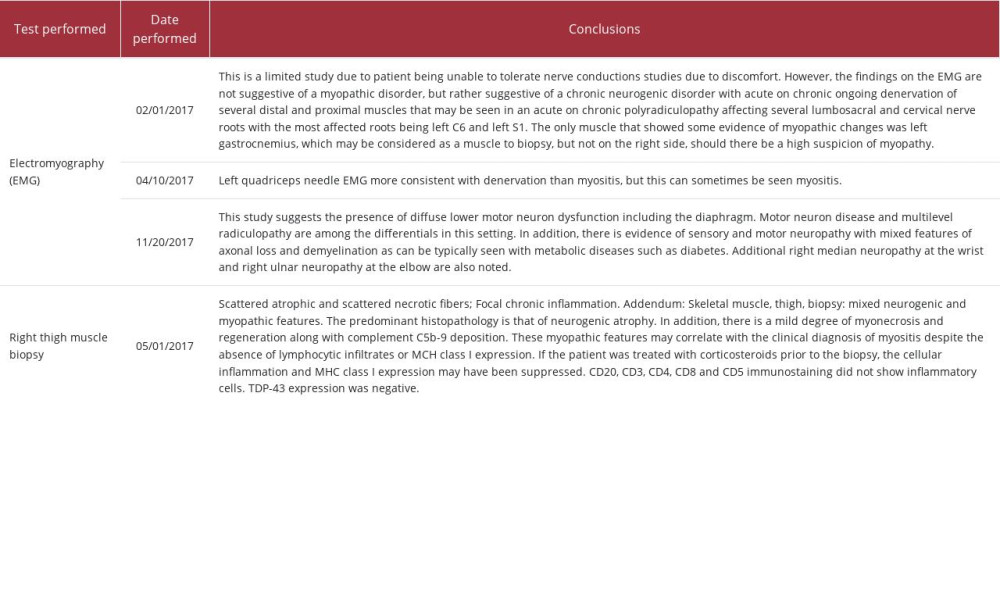08 May 2023: Articles 
Anti-PL12 Anti-Synthetase Syndrome and Amyotrophic Lateral Sclerosis: A Case Report of a Rare Comorbidity
Rare coexistence of disease or pathology
Ejaz A. Shamim12ABCDEF*, Melvin W. Kong1BD, Ivan Y. Lim3BE, Richard J. McCarthy1BD, Sharday N. Grant4BDEF, Harpreet K. Nagi5BDEDOI: 10.12659/AJCR.939035
Am J Case Rep 2023; 24:e939035
Abstract
BACKGROUND: Anti-PL-12 syndrome is a rare form of myositis. Amyotrophic lateral sclerosis (ALS) is the commonest of the motor neuron disorders. However, the 2 conditions have not been reported to occur together in a single individual. This case report describes a patient who was diagnosed with anti-PL-12 anti-synthetase syndrome and then subsequently was diagnosed with ALS.
CASE REPORT: A 55-year-old male patient had anti-PL-12 syndrome and ALS occurring together. The patient initially presented with musculoskeletal complaints and was diagnosed with anti-PL-12 syndrome. He later went on to develop shortness of breath. Neurophysiological testing subsequently confirmed ALS as the patient experienced worsening muscle weakness over a 2-year period. A muscle biopsy performed showed neurogenic and myopathic process. The patient eventually lost the ability to ambulate without mobility assistance and suffered cardiac arrest due to complications from ALS, specifically diaphragmatic dysfunction.
CONCLUSIONS: This case report represents the first documented case of a patient having both anit-PL-12 syndrome and ALS together. It has been suggested that having an autoimmune disease (AID) may increase the subsequent risk of developing ALS. Previous studies did not conduct evaluation to ascertain serological markers for AS antibodies. Lab tests were rechecked and revalidated multiple times in separate facilities for confirmation of results in case of initial lab error. This may suggest a common etiology for both anti-PL-12 syndrome and ALS.
Keywords: Amyotrophic Lateral Sclerosis, Antisynthetase Syndrome, case reports, Male, Humans, Middle Aged, Comorbidity, Syndrome, Muscle Weakness
Background
There is increasing evidence to suggest autoimmune diseases can precede amyotrophic lateral sclerosis (ALS) [1,2], which is a rapidly progressive neurodegenerative condition. Limited data suggest that ALS and other autoimmune diseases, like polymyositis (PM), can co-exist [1,2]. However, there are no reported cases of anti-synthetase syndrome (AS) and ALS occurring together.
Here, we describe a patient who was diagnosed with anti-PL-12 anti-synthetase syndrome and then subsequently was diagnosed with ALS. To the best of our knowledge these 2 conditions have never been reported to occur together in a single individual.
Case Report
A 55-year-old left-handed man developed multiple joint pains in 2015. Blood test (Table 1) revealed elevated anti-citrullinated peptide (anti-CCP) and anti-Sjögren’s syndrome A antibodies (anti-SSA). However, he did not have any joint synovitis. In 2017, he developed recurrent muscle cramps and dyspnea on exertion. Creatine kinase and aldolase were elevated, with normal C-reactive protein. Anti-PL-12 was positive. Pulmonary function testing showed severe restrictive defect with moderate reduction in diffusing capacity. CT scan of the chest showed elevated right hemidiaphragm, but was otherwise negative. EMG showed acute-on-chronic denervation of several distal and proximal muscles. The skeletal muscle histopathology showed mixed, neurogenic, and myopathic features as well as a mild degree of myonecrosis and regeneration along with complement C5b-9 deposition. He received Prednisone, Azathioprine, and intravenous immune globulin (IVIG), but his condition did not improve. He had an allergic reaction to mycophenolate mofetil, manifested by a rash.
By the end of 2017, the muscle weakness worsened, and he was using a walker to ambulate. Muscle atrophy was noted in both shoulders and dorsal webs of the hands. Multiple EMGs and a muscle biopsy were performed (Table 2). Because of shortness of breath without evidence of interstitial lung disease and elevated enzymes, a diaphragmatic EMG was performed at a tertiary hospital. It showed abnormal spontaneous activity and neurogenic units in most of the tested muscles of all extremities, trapezius, and right diaphragm, confirming ALS. By late 2018, he had to use a mobility scooter to get around. In 2020, he went into cardiac arrest due to acute respiratory failure due to diaphragmatic dysfunction from ALS.
Discussion
To the best of our knowledge this is the first reported case of Anti-PL-12 anti-synthetase antibody occurring together with ALS. Although it is unclear, some studies suggest that having an autoimmune disease (AID) may increase the subsequent risk of developing ALS. This may suggest a shared etiology [1–3].
A retrospective study using the all-England hospital record-linkage dataset from 1999 to 2011 considered AID preceding ALS. They calculated the rate ratio from the incidence of ALS in each AID cohort and compared it with the incidence of ALS in a cohort of individuals with no prior history of AID. There was a significantly increased incidence of ALS in those who had a previous diagnosis of AID including PM [1].
A study from Taiwan suggests a similar association with AID and ALS. Taiwan’s Registry of Catastrophic Illness Database of 1778 PM patients found 6 patients subsequently developed ALS [3]. Although there is some debate about whether the initial diagnosis of PM was really the onset of ALS [4], the PM patients met the Bohan and Peter criteria, including EMG and muscle biopsy requirements [5,6]. The study concluded that patients with PM had a higher risk of developing ALS [3]. A similar association was noted in 2021 with AID and ALS in a Swedish population-based study [2].
Myositis is a rare systemic condition. The adjusted annual incidence is 5.8–7.9 per 100 000 person-years and the prevalence is 14–17.4 per 100 000 person-years [7]. About 25% of patients with PM or dermatomyositis have AS antibodies [8]. Of the known antibodies, anti-PL-12 accounts for less than 5% [9]. It is possible that other studies had AS antibodies in their PM cohorts and further evaluations to ascertain serological markers were not conducted. There were initially concerns that the anti-PL-12 antibody result was an error. It was rechecked in the same lab, then it was reconfirmed twice at the Oklahoma Medical Research Foundation’s Arthritis and Clinical Immunology Research Program.
In daily clinical practice, it is rare that both anti-PL-12 syndrome and ALS would occur concurrently in one individual. Knowing the presence of both would help plan treatment and provide prognostic value. The mainstay of therapies for anti-PL-12 syndrome are corticosteroids and other immunosuppressive agents. The prognosis worsens with the presence of interstitial lung disease (ILD), which is typically present in more than 90% of anti-PL-12 syndrome patients [10]. Although our patient had dyspnea, ILD was not present. While only 14% of patients with AS and ILD die at 5 years [11], mortality is known to be very high with ALS, and life expectancy of 3–5 year is typical [12]. It is important to look for concurrent ALS in patients with AS myositis who appear to be progressing more rapidly. ALS is no longer considered a singular entity but rather a continuum consisting of ALS and other phenotypes, including myopathies. These distinct phenotypes are not attributable solely to motor neuron dysfunction and now are thought to be linked to certain genes:
While in myositis the presence of antibodies to the protein synthesizing machinery is well established, similarly targeted antibodies are now described in patients with ALS. The myositis specific antibodies are directed towards the tRNA synthetases and have prognostic value. Anti-PL-12 antibodies are directed specifically against alanyl tRNA synthetase. In a small group of patients with ALS, a mutant Cu,Zn-superoxide dismutase (SOD1) leads to misfolding of mitochondrial proteins, leading to cell toxicity [17]. Lysyl-tRNA synthetase appears to be a target propagating mutant SOD1 toxicity [17]. The presence of higher levels of endogenous autoantibodies against the mutant SOD1 are associated with longer survival in ALS patients. Like the anti-PL-12 autoantibodies, the presence of autoantibodies against mutant SOD1 also has prognostic value in ALS patients [18].
Conclusions
This is the first documented case of anti-PL-12 antibody and ALS occurring in the same patient. In our patient, we feel that both conditions existed together, although the anti-PL-12 antibody was identified first. Associations of these diseases occurring together may possibly suggest a common etiology and pathogenesis.
References:
1.. Turner MR, Goldacre R, Ramagopalan S, Autoimmune disease preceding amyotrophic lateral sclerosis: An epidemiologic study: Neurology, 2013; 81(14); 1222-25
2.. Cui C, Longinetti E, Larsson H, Associations between autoimmune diseases and amyotrophic lateral sclerosis: A register-based study: Amyotroph Lateral Scler Frontotemporal Degener, 2021; 22(3–4); 211-19
3.. Tseng CC, Chang SJ, Tsai WC, Increased incidence of amyotrophic lateral sclerosis in polymyositis: A nationwide cohort study: Arthritis Care Res, 2017; 69(8); 1231-27
4.. Parperis K, Increased amyotrophic lateral sclerosis in polymyositis: Comment on the article by Tseng et al: Arthritis Care Res (Hoboken), 2018; 70(7); 1119-20
5.. Bohan A, Peter JB, Polymyositis and dermatomyositis: N Engl J Med, 1975; 292(7); 344-47
6.. Tseng CC, Chang SJ, Tsai WC, Reply: Arthritis Care Res (Hoboken), 2018; 70(7); 1120
7.. Schmidt J, Current classification and management of inflammatory myopathies: J Neuromuscul Dis, 2018; 5(2); 109-29
8.. Gran TJ, Molberg O, The antisynthetase syndrome: Idiopathic inflammatory myopathies-recent developments, 2011; 65-76, London, IntechOpen
9.. Nishikai M, Reichlin M, Heterogeneity of precipitating antibodies in polymyositis and dermatomyositis: Arthritis Rheumatol, 1980; 23(8); 881-88
10.. Hamaguchi Y, Fujimoto M, Matsushita T, Common and distinct clinical features in adult patients with anti-aminoacyl-tRNA synthetase antibodies: Heterogeneity within the syndrome: PLoS One, 2013; 8(4); e60442
11.. Rojas-Serrano J, Herrera-Bringas D, Mejía M, Prognostic factors in a cohort of antisynthetase syndrome (ASS) : Serological profile is associated with mortality in patients with interstitial lung disease (ILD): Clin Rheumatol, 2015; 34(9); 1563-69
12.. Gordon PH, Amyotrophic lateral sclerosis: pathophysiology, diagnosis and management: CNS Drugs, 2011; 25(1); 1-15
13.. Sabatelli M, Marangi G, Conte A, New ALS-related genes expand the spectrum paradigm of amyotrophic lateral sclerosis: Brain Pathol, 2016; 26(2); 266-75
14.. Mantero V, Rigamonti A, Basso F, When it rains it pours: Amyotrophic lateral sclerosis concealed with Isaac’s syndrome: Neurol Sci, 2016; 7(37); 1181-83
15.. Broccolini A, Mirabella M, Hereditary inclusion-body myopathies: Biochim Biophys Acta, 2015; 1852(4); 644-50
16.. Dimachkie MM, Barohn RJ, Inclusion body myositis: Neurol Clin, 2014; 32(3); 629-46
17.. Kawamata H, Magrané J, Kunst C, Lysyl-tRNA synthetase is a target for mutant SOD1 toxicity in mitochondria: J Biol Chem, 2008; 283(42); 28321-28
18.. van Blitterswijk M, Gulati S, Smoot E, Anti-superoxide dismutase antibodies are associated with survival in patients with sporadic amyotrophic lateral sclerosis: Amyotroph Lateral Scler, 2011; 12(6); 430-38
In Press
14 Mar 2024 : Case report 
Am J Case Rep In Press; DOI: 10.12659/AJCR.942770
16 Mar 2024 : Case report 
Am J Case Rep In Press; DOI: 10.12659/AJCR.943214
16 Mar 2024 : Case report 
Am J Case Rep In Press; DOI: 10.12659/AJCR.943010
16 Mar 2024 : Case report 
Am J Case Rep In Press; DOI: 10.12659/AJCR.943687
Most Viewed Current Articles
07 Mar 2024 : Case report 
DOI :10.12659/AJCR.943133
Am J Case Rep 2024; 25:e943133
10 Jan 2022 : Case report 
DOI :10.12659/AJCR.935263
Am J Case Rep 2022; 23:e935263
19 Jul 2022 : Case report 
DOI :10.12659/AJCR.936128
Am J Case Rep 2022; 23:e936128
23 Feb 2022 : Case report 
DOI :10.12659/AJCR.935250
Am J Case Rep 2022; 23:e935250










